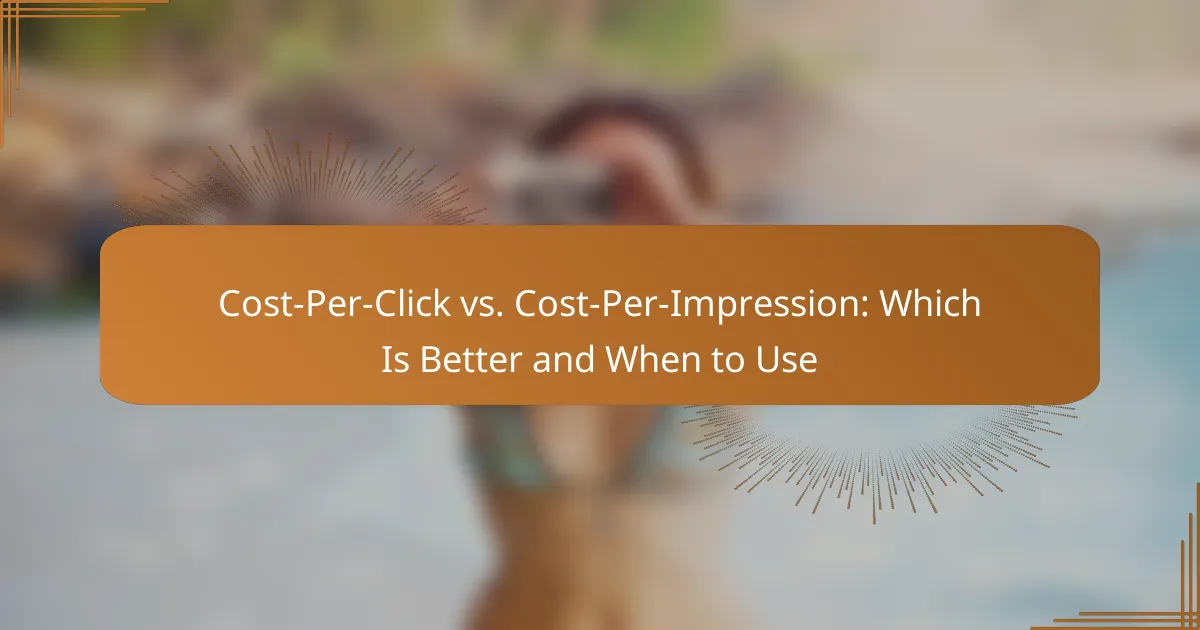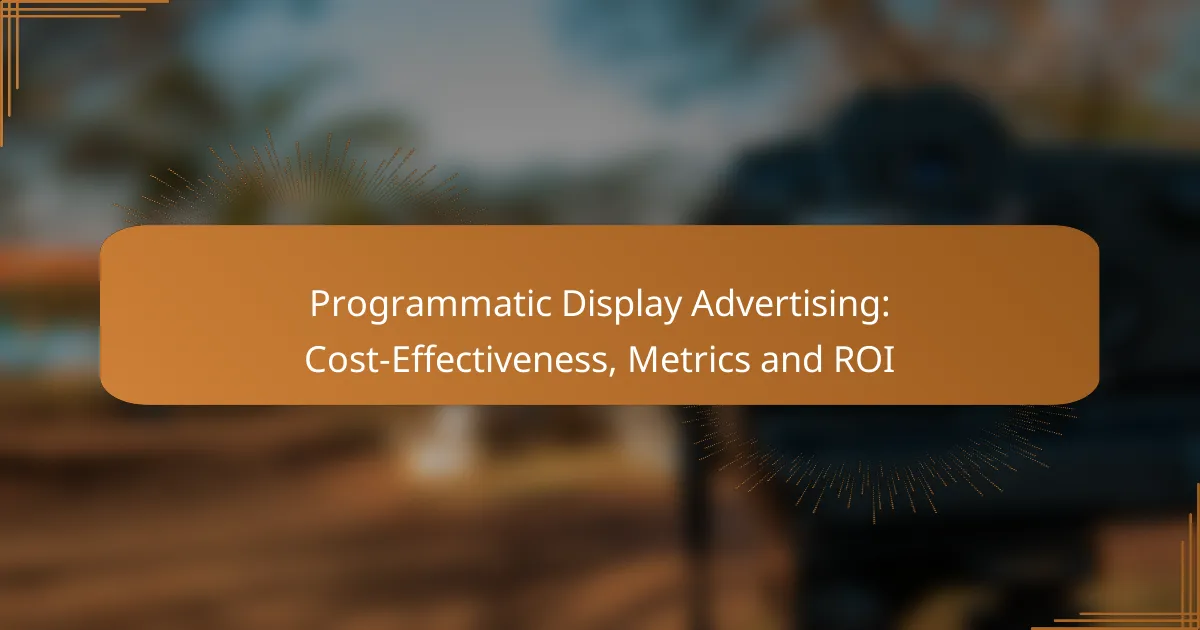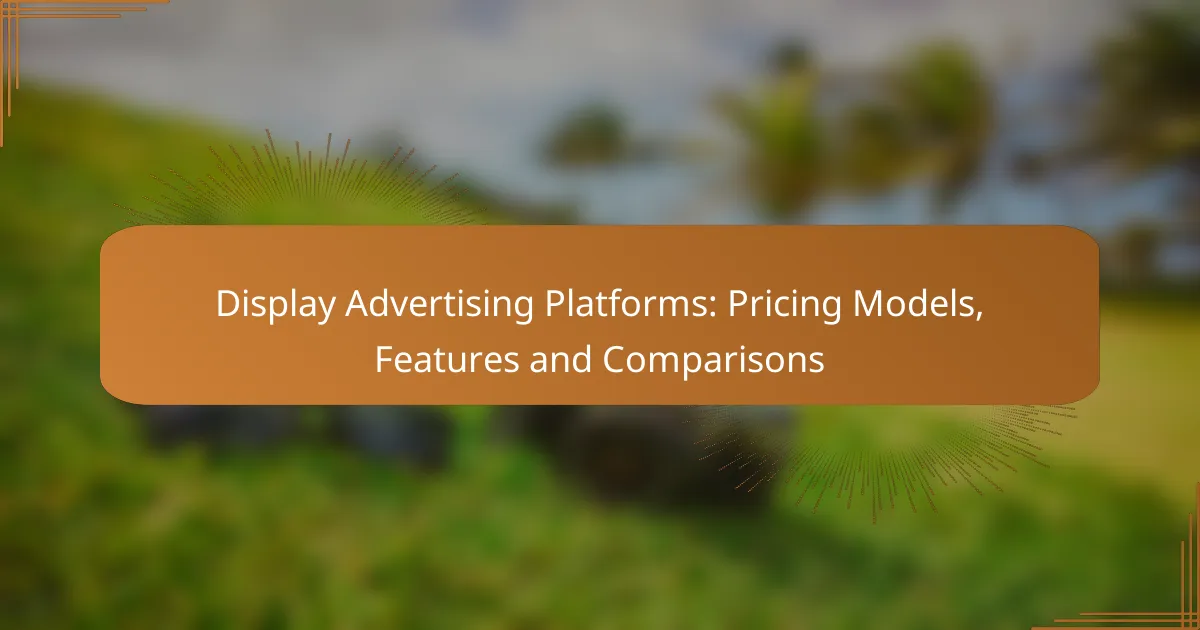Understanding the differences between Cost-Per-Click (CPC) and Cost-Per-Impression (CPI) is crucial for optimizing your advertising strategy. CPC focuses on driving traffic by charging advertisers only when users click on their ads, making it ideal for campaigns aimed at engagement and conversions. In contrast, CPI prioritizes visibility, charging for each ad impression regardless of clicks, which is beneficial for enhancing brand awareness. Choosing the right model depends on your specific marketing goals and desired outcomes.
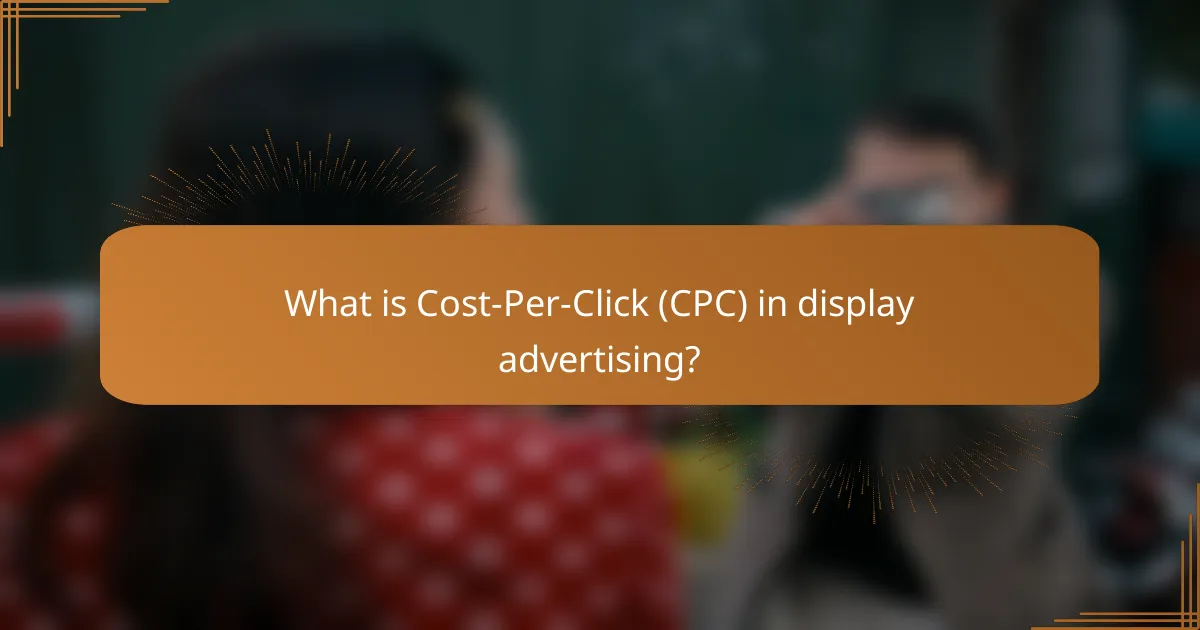
What is Cost-Per-Click (CPC) in display advertising?
Cost-Per-Click (CPC) in display advertising refers to the amount an advertiser pays each time a user clicks on their ad. This pricing model is commonly used to drive traffic to websites, making it essential for campaigns focused on user engagement and conversions.
Definition of Cost-Per-Click
Cost-Per-Click (CPC) is a digital advertising model where advertisers pay a fee each time their ad is clicked. This model is particularly popular in search engine marketing and display advertising, as it allows advertisers to only pay for actual engagement rather than just ad visibility.
In CPC campaigns, the cost can vary widely based on factors such as competition, industry, and the specific keywords being targeted. Advertisers often set a maximum bid they are willing to pay per click, which helps control their advertising budget.
How CPC works in display advertising
CPC in display advertising operates through an auction system where advertisers bid on ad placements. When a user visits a webpage, an auction occurs in milliseconds to determine which ads will be displayed based on the bids and relevance. The highest bidder typically wins the placement, but quality factors also play a significant role.
To optimize CPC campaigns, advertisers should focus on targeting the right audience and selecting high-performing keywords. Regularly analyzing click-through rates (CTR) and adjusting bids can help maximize the return on investment. It’s advisable to avoid overly broad targeting, which can lead to wasted clicks and increased costs.
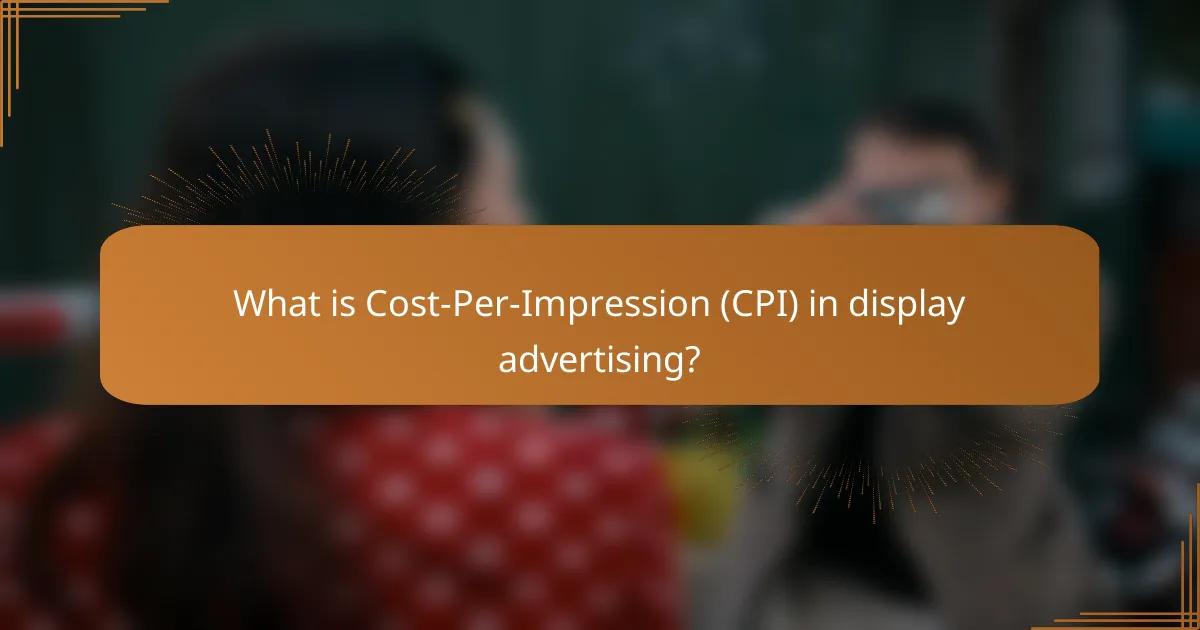
What is Cost-Per-Impression (CPI) in display advertising?
Cost-Per-Impression (CPI) is a pricing model in display advertising where advertisers pay for each time their ad is shown, regardless of whether it is clicked. This model focuses on maximizing visibility and brand awareness rather than direct engagement.
Definition of Cost-Per-Impression
Cost-Per-Impression refers to the cost incurred by an advertiser for every thousand impressions of their ad. It is commonly abbreviated as CPM (Cost Per Mille). Advertisers often choose this model to enhance brand visibility and reach a broader audience.
In this model, the payment is based on the number of times the ad is displayed, not on user interaction. This makes it suitable for campaigns aiming to build brand recognition rather than drive immediate sales.
How CPI works in display advertising
CPI operates by charging advertisers a set fee for every thousand times their ad appears on a website or app. The cost can vary based on factors such as the ad placement, audience targeting, and the overall demand for ad space. Advertisers typically negotiate rates with publishers or use automated platforms to manage their campaigns.
For example, if an advertiser agrees to a CPI of $5, they will pay $5 for every 1,000 impressions their ad receives. This model is particularly effective for businesses looking to promote brand awareness in competitive markets.
When using CPI, advertisers should monitor the performance of their campaigns closely. It’s important to ensure that the impressions are reaching the intended audience to maximize the return on investment. Avoiding overly broad targeting can help maintain relevance and effectiveness.

When should you use Cost-Per-Click?
Cost-Per-Click (CPC) is best used when your primary goal is to drive traffic to your website and generate leads or sales. This model is particularly effective when you want to pay only for actual engagement, rather than just impressions.
Best scenarios for using CPC
CPC is ideal for campaigns focused on direct response, such as e-commerce promotions or lead generation. If you have a clear call-to-action and a landing page designed to convert visitors, CPC can maximize your return on investment.
Additionally, using CPC makes sense when targeting specific keywords that are likely to attract high-intent users. This strategy can be particularly beneficial in competitive markets where every click counts towards achieving your business goals.
Advantages of CPC in campaigns
One of the main advantages of CPC is that it allows you to control your advertising budget more effectively. You only pay when someone clicks on your ad, which can lead to a more efficient allocation of resources compared to paying for impressions.
CPC campaigns also provide valuable data on user behavior and engagement. By analyzing click-through rates and conversion metrics, you can optimize your ads and targeting strategies over time, improving overall campaign performance.
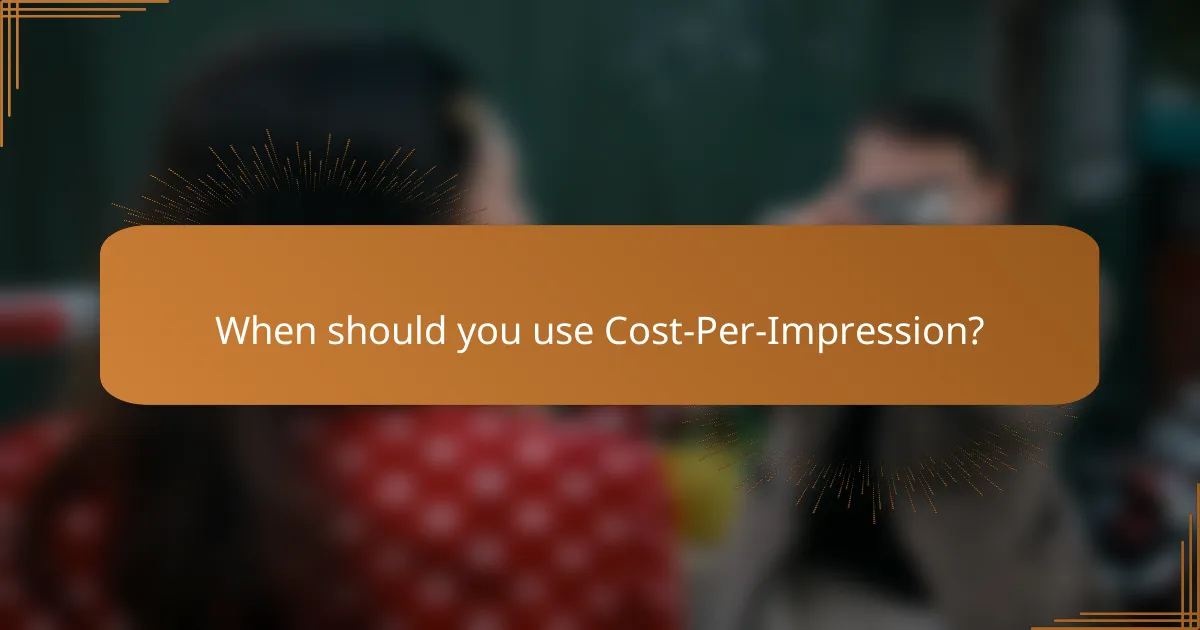
When should you use Cost-Per-Impression?
Cost-Per-Impression (CPI) is best used when brand visibility is a priority over direct conversions. This model is ideal for campaigns focused on generating awareness rather than immediate clicks or sales.
Best scenarios for using CPI
CPI is particularly effective for campaigns aimed at broad audiences where the goal is to enhance brand recognition. For instance, launching a new product or entering a new market can benefit from a high impression count to build familiarity.
Additionally, CPI works well in industries where the customer journey is longer, such as luxury goods or real estate, where repeated exposure can influence purchasing decisions over time.
Advantages of CPI in campaigns
One major advantage of using CPI is cost efficiency in reaching a large audience. Advertisers can achieve significant visibility without the need for immediate engagement, which is beneficial for brand-building efforts.
CPI campaigns can also provide valuable data on audience reach and engagement patterns, allowing marketers to refine their strategies over time. This model is often more predictable in terms of budgeting, as costs are based on impressions rather than clicks, which can fluctuate widely.

How do CPC and CPI compare?
CPC (Cost-Per-Click) and CPI (Cost-Per-Impression) are two distinct pricing models in digital advertising. CPC charges advertisers based on the number of clicks their ads receive, while CPI charges based on the number of times ads are displayed, regardless of clicks.
Key differences between CPC and CPI
The primary difference between CPC and CPI lies in how advertisers are billed. With CPC, costs are incurred only when a user clicks on the ad, making it performance-oriented. In contrast, CPI charges advertisers for every impression, which can be beneficial for brand visibility but may not guarantee engagement.
Another key difference is the type of campaigns suited for each model. CPC is often preferred for campaigns focused on direct response and conversions, while CPI is more suitable for brand awareness campaigns where the goal is to reach a larger audience without immediate action.
Cost-effectiveness analysis of CPC vs. CPI
When evaluating cost-effectiveness, consider the campaign goals. If the objective is to drive traffic and conversions, CPC may provide better value as you only pay for actual clicks. However, if the aim is to enhance brand recognition, CPI can be more effective, as it allows for broader reach at potentially lower costs per impression.
To determine which model is more cost-effective for your needs, analyze historical performance data. For instance, if a CPC campaign yields a high conversion rate, it may justify the higher cost per click. Conversely, if a CPI campaign generates significant impressions leading to brand recall, it could be worth the investment.
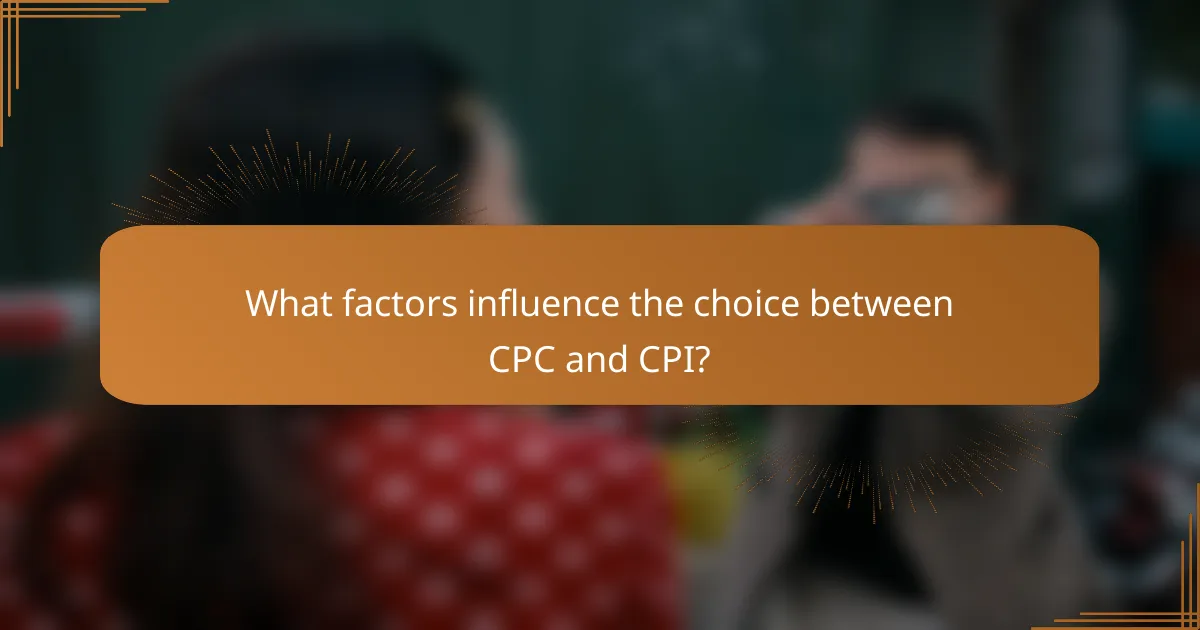
What factors influence the choice between CPC and CPI?
The choice between Cost-Per-Click (CPC) and Cost-Per-Impression (CPI) depends on various factors including the target audience, campaign goals, and the overall marketing strategy. Understanding these elements can help advertisers optimize their spending and achieve better results.
Target audience considerations
Identifying your target audience is crucial when deciding between CPC and CPI. If your audience is more likely to engage with ads through clicks, CPC may be the better option. Conversely, if brand visibility is the primary goal, CPI can be more effective as it focuses on impressions rather than direct engagement.
Consider demographics, interests, and online behavior. For instance, younger audiences may respond better to interactive ads that encourage clicks, while older demographics might prefer straightforward brand messaging that can be delivered through impressions.
Campaign goals and objectives
Your campaign’s goals significantly influence whether to use CPC or CPI. If the objective is to drive traffic to a website or generate leads, CPC is typically more suitable as it directly ties costs to user actions. In contrast, if the goal is to build brand awareness or reach a larger audience, CPI can be more advantageous.
Establish clear metrics for success. For example, if you aim to increase website visits, focus on CPC. If you want to enhance brand recognition, prioritize CPI. Regularly assess campaign performance to determine which model aligns best with your objectives and adjust as necessary.
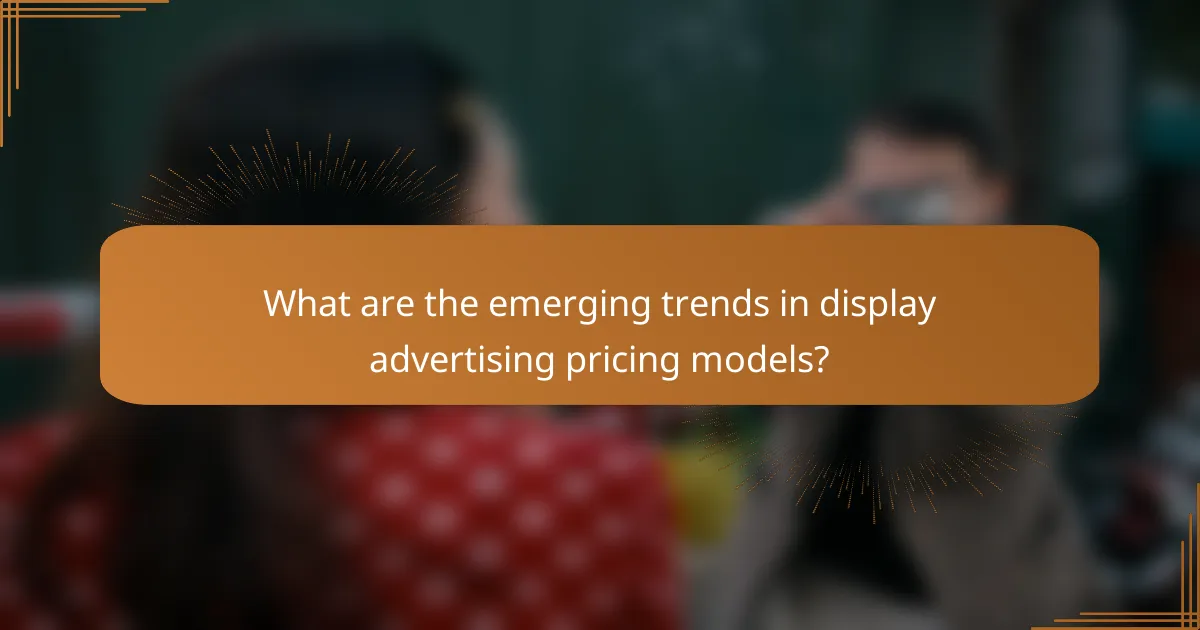
What are the emerging trends in display advertising pricing models?
Emerging trends in display advertising pricing models include a shift towards hybrid pricing strategies and the influence of artificial intelligence on cost-per-click (CPC) and cost-per-impression (CPI) approaches. Advertisers are increasingly seeking flexible models that optimize their spending based on campaign goals and audience engagement.
Shift towards hybrid pricing models
Hybrid pricing models combine elements of both CPC and CPI, allowing advertisers to balance cost efficiency with visibility. This approach enables marketers to pay for impressions while also incentivizing clicks, creating a more comprehensive strategy that can adapt to various campaign objectives.
For example, a brand might use a hybrid model for a product launch, paying for impressions to build awareness while also focusing on clicks to drive conversions. This flexibility can lead to better overall performance, especially in competitive markets.
Impact of AI on CPC and CPI strategies
Artificial intelligence is transforming CPC and CPI strategies by enabling more precise targeting and optimization. AI algorithms analyze vast amounts of data to identify patterns in user behavior, allowing advertisers to adjust their bids in real-time based on the likelihood of engagement.
As a result, campaigns can become more cost-effective, with AI-driven tools helping to allocate budgets dynamically. Advertisers should consider leveraging AI technologies to enhance their strategies, ensuring they remain competitive in a rapidly evolving digital landscape.
